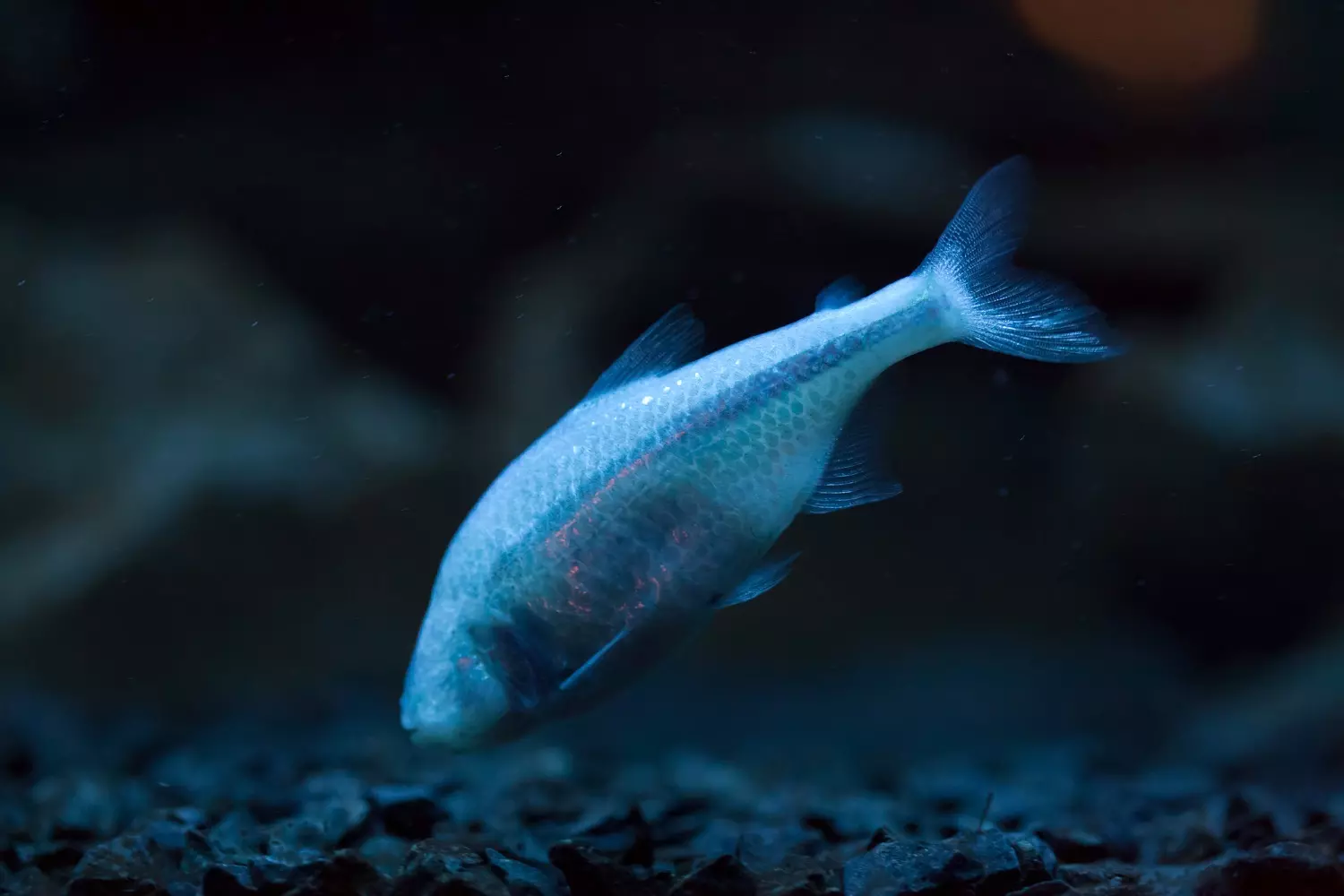[Originally published as The Surprising Reason that Some Cave Fish are Blind]
The Mexican tetra (Astyanax mexicanus) can be found living in fresh water above or below ground. The ones living in water above ground are “normal,” but the ones living in water below ground (where light is scarce or nonexistent) are blind. As you can see from the picture above, they don’t even have noticeable eyes. Why? The standard view has always been that seeing things takes a lot of energy, so if you can’t see anything because it is always dark, it doesn’t do any good to waste energy on a visual system. However, if you can see things, it is worth the energy, because a visual system allows you to more easily find food, avoid predators, find a mate, etc.
So, if you are a Mexican tetra living in the waters on the surface of the earth and disabling mutations occur in the genes of your visual system, your fellow Mexican tetras will out-compete you, and you will probably die without passing on those mutations to the next generation. However, if you are a Mexican tetra living in the dark and get the same disabling mutation, it will not affect your ability to survive and pass that mutation on to the next generation. As a result, mutations in the visual systems of underground Mexican tetras accumulated over time, leading to blind cave fish.
A couple of years ago, a study confirmed the first part of this story. By comparing the blind version of the species to the version that can see, they showed that the energy “cost” of having a visual system was 5%-15% of the fish’s total metabolism, depending on the size of the fish. As a result, it makes sense that fish who do not use their visual system (like cave fish) would be better off not having one. However, the second part of the story (mutations building up to disable the system) seems to have been falsified, at least for this particular species.
The authors of the study looked at the genes that are known to be responsible for producing eyes in normal Mexican tetras and found that they are not significantly different from those in blind Mexican tetras. In other words, the genes for eyes in blind Mexican tetras have not been disabled by mutations. Instead, the authors found that those unbroken genes have been “turned off” through a process called methylation.
What is methylation? One of the simplest chemical components in organic chemistry is called the “methyl group.” It is a carbon atom attached to three hydrogen atoms. Methylation is a process that adds this group to a molecule, changing its chemistry. With the proper chemical machinery, a methyl group can be added to any molecule, including DNA. When a methyl group is added to DNA, it doesn’t change the genes in any way, but it affects how much they are used. If done correctly, adding a methyl group to the right places on DNA can keep the genes from being used at all. In other words, DNA methylation can “turn off” genes without changing them.
That’s what seems to have happened in these cave fish. It is called an epigenetic change, because the genes themselves don’t change. Instead, something “on top” of the genes (a methyl group) causes the change. Geneticists have known about epigenetic changes for a long time. It is probably one way an organism adjusts to changes in its life and environment. However, it was originally thought that epigenetic changes aren’t passed on from generation to generation. As time has gone on, however, there have been a lot of studies that indicate such changes can be passed on to subsequent generations. Indeed, this seems to be one of those studies. Rather than mutations disabling the genes of blind Mexican tetra, epigenetics has simply turned them off, and that “off” switch has been passed down through the generations.
If this study is confirmed (I haven’t seen a peer-reviewed version yet), it will probably be hotly contested for a while. Why? Because we know that epigenetics is influenced by an organism’s surroundings. Thus, this study seems to say that the blind cave fish’s surroundings caused its evolution from having eyes to not having eyes. This is anathema to the standard NeoDarwinian view of evolution, which sees all evolutionary change as random, because it is caused by random mutations in the DNA. It isn’t “directed” by anything, including the organism’s surroundings. Of course, once this random change happens, it is subjected to natural selection, and the surroundings play a role in that process. However, the actual change itself is supposed to be completely random.
This study seems to indicate that the surroundings play a role in the change itself, before natural selection has a chance to act. Creationists have argued that many adaptations we see in nature are caused this way. The Creator designed into His creation the ability to adapt, and He designed mechanisms that would allow that adaptation to be directed by the organism’s surroundings. Epigenetics may be one of those mechanisms.
Please note that this is not the first adaptation that has been shown to be directed by an organism’s surroundings. Lenski’s famous Long Term Evolution Experiment has demonstrated that gene changes can also be directed by the environment, at least in the case of bacteria adapting to eat a food that they don’t normally eat in presence of oxygen. Thus, the creationist idea of the surroundings influencing adaptive change seems to be getting more and more confirmation as time goes on.







Because of years of evolutionary indoctrination in the university before giving my life to Christ, I used to struggle with the features of many animals that appear to be designed for carnivory. If the Bible says there was no death before the fall, why do many animals look like they were made for meat-eating? But seeing the changes God made in the serpent in an instant, and reading things like this article, it is so easy! Our supreme Designer in his foreknowledge programmed all of these features for adaptation and change within each creature! Maybe my thoughts here aren’t directly related to your article, but it “turned some genes on” in my little brain! Thanks Dr. Wile!